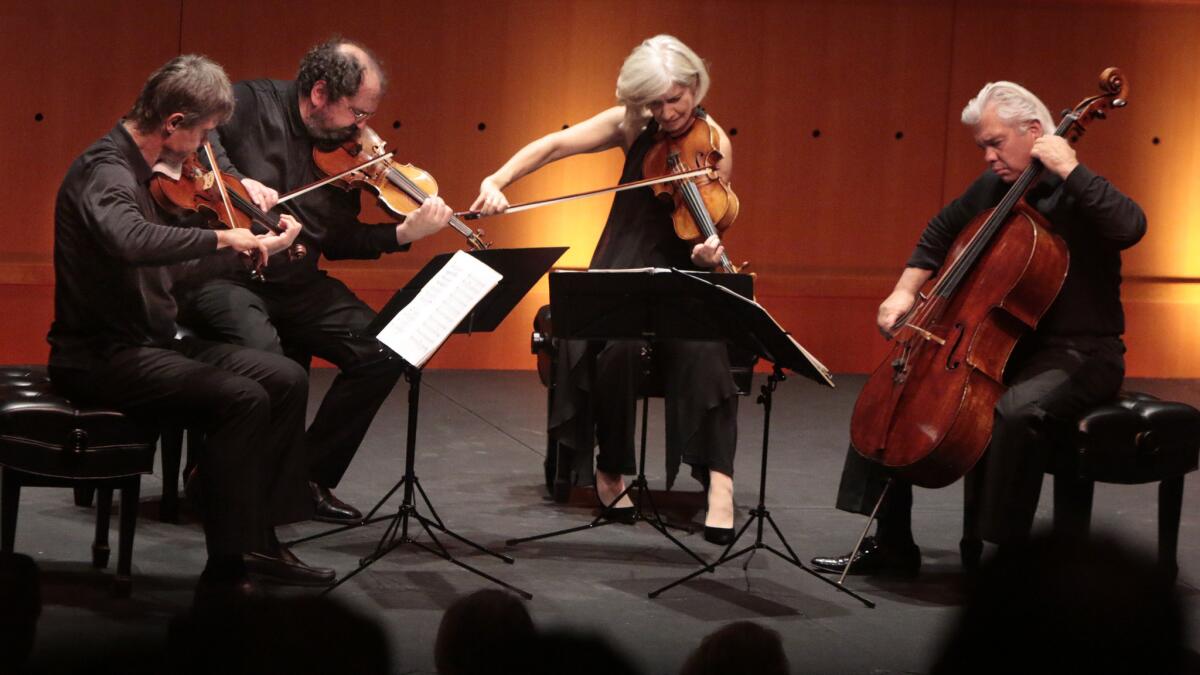Hagen Quartet shows exquisite unity in rare SoCal concert

- Share via
The official biography of the Hagen Quartet, which made a rare Southern California appearance at the Samueli Theater in Costa Mesa on Tuesday night, begins with a quote from a Zurich newspaper calling the ensemble “undoubtedly the world’s most famous quartet.”
Not around here it isn’t, or probably even in Zurich. The Kronos, the Emerson and the Juilliard happen to be three string quartets with far greater international fame.
That doesn’t mean that the Hagen, formed in Germany in 1981 by four young siblings, isn’t one of the world’s greatest. A connoisseur’s group, not a populist one, the Hagen has made a number of gripping recordings and toured Europe extensively.
But the Hagen doesn’t bother too much with the high-profile side of the music business that would make it world famous. It tends to show up at the kinds of European festivals more noted for dedication than glamour.
It may be the only string quartet in existence that doesn’t bother to have a website.
The quartet’s Los Angeles debut was 30 years ago at the Olympic Arts Festival when its players were exciting new kids on the block. That was followed by a couple of appearances in Laguna in the ‘80s, and although the Hagen makes occasional stops on the East Coast, it hasn’t been back our way since.
Since 1986, the group has been the three original Hagens (first violinist Lukas, violist Veronika and cellist Clemens) and Rainer Schmidt (second violin). But the unity of playing in a fairly conventional program of Mozart, Shostakovich and Brahms on Tuesday is something not to be found anywhere else.
Part of the fun of observing most string quartets is a listener playing armchair psychologist, trying to imagine the fascinating relationships between the players. How strong is the leader, which is the first violinist? How do the individual personalities interact? There are stories, such as the members of the great Budapest String Quartet in the mid-20th century insisting on taking separate trains.
In the case of the Hagen, two brothers and a sister sharing a strong family resemblance are joined by a tousled, bushy-haired outsider. But the family resemblance in the playing of all four is unmistakable. Employing little vibrato, each produces a similar finely gauged, gleaming tone that blends perfectly with the others.
Together, they reveal a group physicality that it might seem only Chinese acrobats can achieve. The players phrase melodies as though finishing each other’s thoughts. And yet in solo lines, there is a sense of distinctiveness, each musician bringing something special to an argument yet moving that argument to a higher purpose.
This is, in other words, the ideal string quartet.
Mozart is a specialty of the Hagen, and the program began with the composer’s String Quartet in G, K. 387. It is a subtle score, full of harmonic trickery, elegant phrases that go awry, then get back on track before you quite realize what is happening.
The Hagen emphasized slippery smooth but also sly grace. The bigger picture was always evident, the forward direction sure. But like ants at work, there was continual movement underneath. It was brilliantly sneaky, even subversive Mozart.
Shostakovich’s String Quartet No. 8 was simply brilliant. In this 1960 quartet, Shostakovich’s most popular, a neurotic, long-oppressed Soviet composer fixatedly fiddles with a musical theme based on the initials of his name. By focusing each instrument with laser-like intensity on Shostakovichian angst, the Hagen here created an inner narrative in which glassy quiet might be broken by such viscerally and impeccably directed violence that a listener might be tempted to duck the blows.
Brahms’ third and final quartet, Op. 67, completed the program with yet a third kind of unity. The slow movement is a lovely song without words, in which one instrument begins a melody and another picks it up midstream, and then another. And like Mozart, Brahms’ quartet is ever changeable, the composer constantly interrupting himself with a new idea that might not seem to fit.
The Hagen clearly can’t stand anything not fitting, not being polished to an exquisite degree, not making sense. This Brahms always fit, but in such a way that the discrete pieces of a string quartet puzzle were not so much joined because they interlock like pieces of a jigsaw puzzle but because a greater purpose is implied, such as a unified theory of nature. It was an inspiring concert.
Twitter: @markswed
More to Read
The biggest entertainment stories
Get our big stories about Hollywood, film, television, music, arts, culture and more right in your inbox as soon as they publish.
You may occasionally receive promotional content from the Los Angeles Times.











